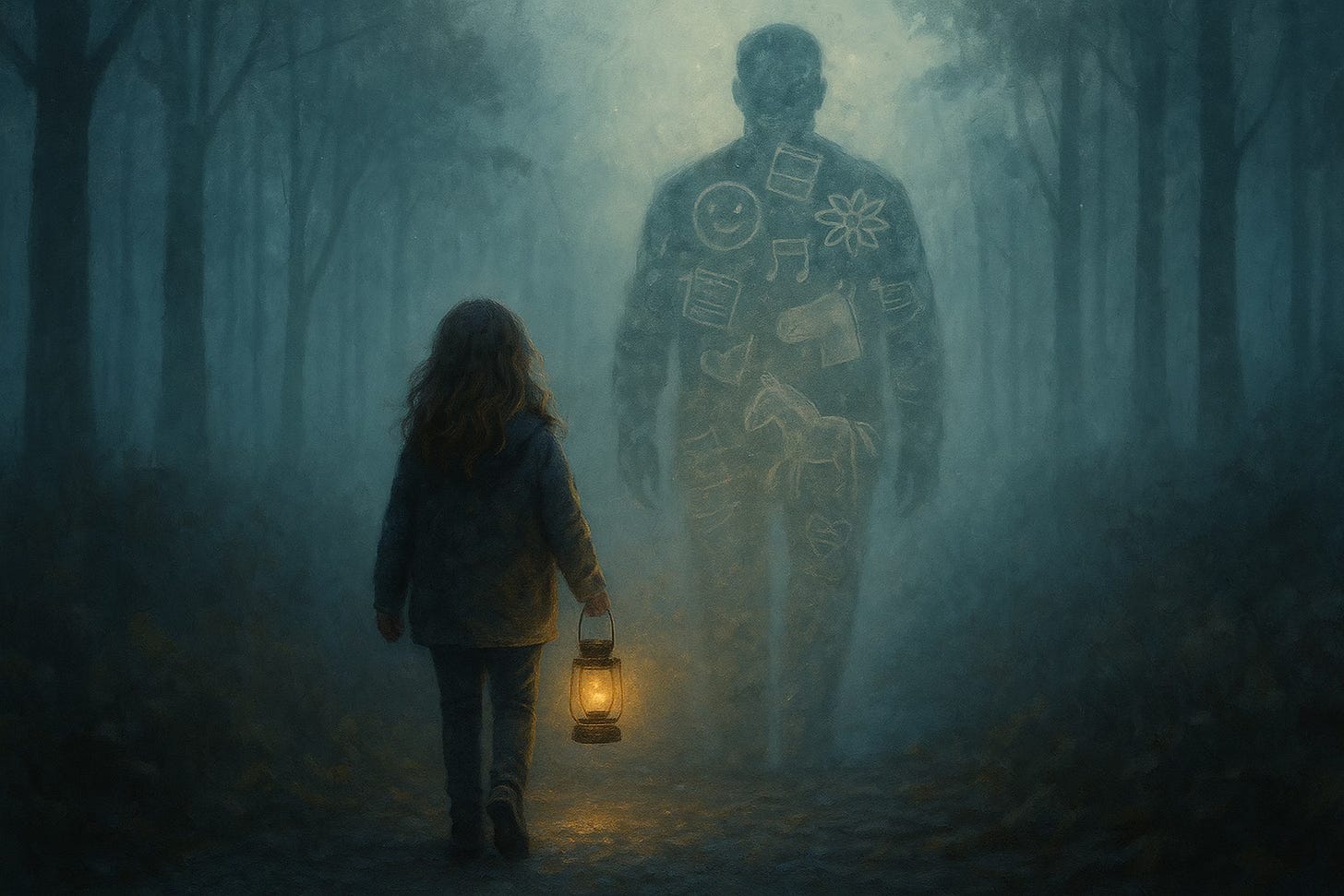The Memory We Held Together
Memories built with children shape their identity, belonging, and emotional security. Meaning forms through shared presence—not just observation.
In the quiet space between a car door shutting and a juice box opening, something quietly profound began to grow. What started as a simple post-practice ritual—asking my daughter about her day—gradually became something far more lasting. We called it the Challenge Interview. Over time, it became a mirror, a rhythm, a soft architecture where she could begin to shape herself.
And as her answers deepened, I realized something just as meaningful: I wasn’t just listening. I was holding. Holding her meanings, her memories, her small dignities—until she could carry them on her own.
This isn’t just a parenting story. It’s a quiet act of resistance—against the algorithmic erosion of childhood, against the drift from reflection to reaction. In a time when coherence is becoming rare and machine-generated everything saturates our lives, presence becomes sacred. We’re no longer just raising children—we’re defending the narrative scaffolds that let them become whole.
At first, the questions were light and inviting.
“What part of today felt like a walk? A gallop?”
“What surprised you?”
“What stretched you?”
No tricks. No agenda. Just curiosity, served as gently as a glass of water. I wasn’t chasing teachable moments. I was laying a path—question by question—between what she did and how it lived in her.
Then—like noticing a tide only after your feet are wet—something shifted. Her answers expanded. She began to narrate herself. I saw patterns emerge: which activities energized her, which mentors awakened her, which peers dimmed or brightened her.
This wasn’t just reflection. It was authorship. And in a culture that confuses performance with personhood, that kind of slow narrative agency felt quietly insurgent.
“I wasn’t just present for her growth. I became a living archive of it.”
In rehabilitation medicine, there’s a term—embodiment—for the moment when a prosthetic limb feels like part of you. I think parenting has an emotional version of that.
I wasn’t just there as she grew. I became the archive of her becoming.
I remembered her joy when she forgot it. I noticed her rhythms before she recognized them. When she felt unmoored, I could quietly remind her: you’ve stood here before—and steadied yourself.
I became her prosthetic rhythm. Her backup memory. Her emotional mirror.
This wasn’t supervision. It was containment. Not correction, but dignity held in trust.
And in a parenting culture wired for dashboards and diagnostics, this wasn’t just old-fashioned—it was subversive. No charts. No mental health apps. No gamified resilience. Just presence. Just story. Just memory—patient, unmeasured, and human.
Children don’t build identity in isolation. They build it in rhythm, metaphor, and reflection. For us, metaphor became the medium.
When she said, “Today was a gallop,” I didn’t cheer. I asked, “What made it a gallop?” And then the story poured out: a new friend, a small triumph, a moment of risk.
Those metaphors—walk, trot, canter, gallop—weren’t metrics. They were orientation tools. Emotional coordinates for a mind still sketching its map.
We live in a culture urging kids to quantify themselves before they can name what they feel. Steps. Streaks. Scores. Screens that tally but don’t translate. But narrative isn’t a dashboard. It doesn’t care how fast you move if you don’t know who’s moving.
Meaning demands pause. Memory needs witness. And coherence? It’s stitched together one conversation at a time.
“In offering rhythm and reflection to someone else, you often rediscover your own.”
I didn’t expect the mirror to turn.
I entered the ritual thinking it was for her. But somewhere between her fifth gallop and her fiftieth surprise, I noticed my own drift. My distraction. My absence.
I hadn’t just learned who she was becoming—I’d remembered someone I was in danger of forgetting.
That’s the quiet exchange hidden inside rituals like this. You think you're anchoring someone else—then realize you’ve found footing, too.
And in a world that sells distraction as lifestyle, that kind of re-centering feels revolutionary.
Eventually, the rhythm relaxed.
She didn’t need metaphors every day. Sometimes just a glance. A sigh. A phrase. But the cadence we had created stayed alive in her.
“I galloped in science but crashed during lunch.”
Or: “Mostly a walk—but I liked it.”
What I once carried for her, she now carried herself.
But she carried it with dignity. With narrative fluency. With the quiet self-possession of someone who doesn’t need applause—just understanding.
And that, I realized, was the actual arc. Not the ritual. Not the structure. The transfer—from shared meaning to sovereign voice.
And that’s the one metric no app, no test, no system is calibrated to capture.
“You don’t just raise a child. You become the living memory of their becoming.”
Even now, long after the daily Challenge Interviews have faded, the thread remains. I can still feel it.
Because here’s what these small rituals do: they don’t fade. They echo. They stretch across years, across rooms, across silences. They hum inside the architecture of who we become.
And one day, without warning, you’ll hear your child say something—offhand, but rooted—and you’ll realize they’re still moving to a rhythm you started long ago.
You don’t just raise a child.
You become the living memory of their becoming.
And sometimes—if you’ve done your job quietly enough—they return the favor.
In a world that fractures attention, flattens identity, and sells childhood back to us in loops and metrics, reflection isn’t a soft skill. It’s a lifeline.
Because this isn’t just about my daughter. It’s about any child still allowed to carry a story before the world scripts one for them.
We weren’t just talking.
We were building a self.
Together.



